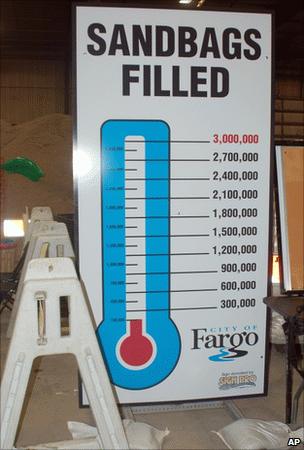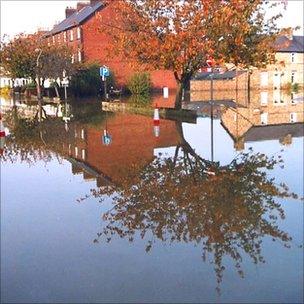Climate change raises flood risk, researchers say
- Published

More accurate assessment of rainfall patterns will help communities prepare for floods
Greenhouse gas emissions are making extreme rainfall events more common, scientists say - and in the UK, have increased the risk of flooding.
Two research groups present their findings in the journal Nature.
Using real-world data and computer models, one team says, external it has proven the link between greenhouse emissions and the observed increase in extreme rains in the Northern Hemisphere.
The other says, external greenhouse warming made the UK floods of 2000 more likely.
That autumn saw the highest rains in England and Wales since records began in 1766.
The Hampshire village of Hambledon was underwater for six weeks, and insurers put the final cost to the country at more than £1bn.
A research team led from Oxford University ran computer models of the atmosphere as it actually was, and parallel models of the atmosphere as it would have been without the carbon dioxide and other greenhouse gases that had accumulated from humanity's emissions.
This produced projections of rainfall patterns, which were then fed into a further model that translated rainfall into the impact on river basins across England and Wales.
The 2000 floods occurred when river basins filled up rapidly.
"We looked at how greenhouse gas emissions affected the odds of a flood," related Pardeep Pall, the Oxford researcher who led the study.
"We found that the emissions substantially increased the odds of a flood occurring in 2000, with about a doubling of the likelihood."
Global influence
In the second study, researchers from Canada and the UK looked at the increase in the frequency of extreme rainfall events documented across much of the Northern Hemisphere between 1950 and 2000.
There are variations from year to year and from place to place; but across the piece, intense downpours have become more common over the period.
The researchers suggest there is nothing that can explain this trend except the slow steady increase in temperatures caused by greenhouse gas emissions.
"In North America, precipitation extremes correspond to the El Nino effect in pretty characteristic ways, where some regions get heavy rainfall while others receive less extreme precipitation," said Francis Zwiers from the University of Victoria in Canada.
"But we don't see these spatial variations in our study, and our models don't generate that kind of spatial structure either.
"The evidence is leading us in another direction, to a phenomena that influences precipitations in a global scale - and the only thing we can think of is the changing composition of the atmosphere."
For decades scientists have believed that on a global scale, a warmer world should be a wetter one, as warm air holds more moisture than cold air.
But the researchers say this is the first "formal identification" of the link between emissions and intense rains.
They also found that a number of the computer models commonly used in research currently underestimate the extent to which heavy rains have increased.
Model concerns
Both research groups were at pains to emphasise that these two papers are not the end of the road.

Climate change probably increased the likelihood of the 2000 flood, the researchers calculate
More research needs to be done, they say, with better records needed from regions of the world where data is scarce, improvements in models, and an extension to other types of weather event.
"There will be for some time to come extreme weather events happening that have been made less likely by human influence on climate," said Myles Allen, one of the Oxford group behind the year 2000 analysis.
"Disentangling these things and deciding which events have been made more likely and which less likely is a difficult but a very interesting scientific endeavour."
This was a point taken up by Sir Brian Hoskins from the Grantham Institute for Climate Change Research, who was not involved with either of these studies.
"Both studies depend heavily on the accuracy of their computer models," he told reporters.
"We need to understand better the actual physics of different flooding events and make sure that the models are able to capture this. Studies like these should be repeated as models continue to improve."
Researchers said they also needed to include other changes to the atmosphere in future analyses, such as the tiny aerosol particles of dust that reflect sunlight back into space.
'Alarming' picture
If the risk of floods is increasing, policymakers will have to ask themselves how to respond; and in the UK, the government has come under fire in recent weeks having cut the flood defence budget by 8% earlier this month.
But a spokesman for the Department for Environment, Food and Rural Affairs (Defra) said the implications of the research - which Defra partially funded - were being taken on board.
"This work reinforces the scientific evidence that the UK needs to tackle climate change and become more resilient to the likelihood of extreme weather events caused by climate change," he said.
"Defra will spend more than £2.1billion over the next four years to provide greater protection to at least 145,000 homes. Defra is also exploring innovative new ways of managing flood risk, such as supporting three land management demonstration projects to see if the rate at which rainfall enters watercourses can be slowed."
Bjorn Lomborg, the Danish "sceptical environmentalist" who was in London for a seminar, told BBC News that society had to look at where and how people lived.
"Some people criticise computer models and of course they are only computer models, but it's the only way we can talk about the future, through models - so I don't disagree with using models," he said.
"But is the right way to handle future flooding by focusing on climate change? The answer is no - that's an incredibly expensive way of making extreme flooding very slightly less likely in 100 years.
"We should focus on the simple ways - making better protection, making sure people don't settle on flood plains, and that we have some places where rivers can naturally flood as they did in the past."
As Professor Lomborg was speaking to the BBC in London, Christiana Figueres, executive secretary of the UN climate convention (UNFCCC), was telling the Spanish parliament that tackling emissions was becoming ever more of a priority.
"It is alarming to admit that if the community of nations is unable to fully stabilise climate change, it will threaten where we can live, where and how we grow food and where we can find water - the very stability on which humanity has built its existence.
"On a global level, increasingly unpredictable weather patterns will lead to falling agricultural production and higher food prices, leading to food insecurity.
"Recent experiences around the world clearly show how such situations can cause political instability and undermine the performance of already fragile states."
- Published9 February 2011
- Published23 October 2010